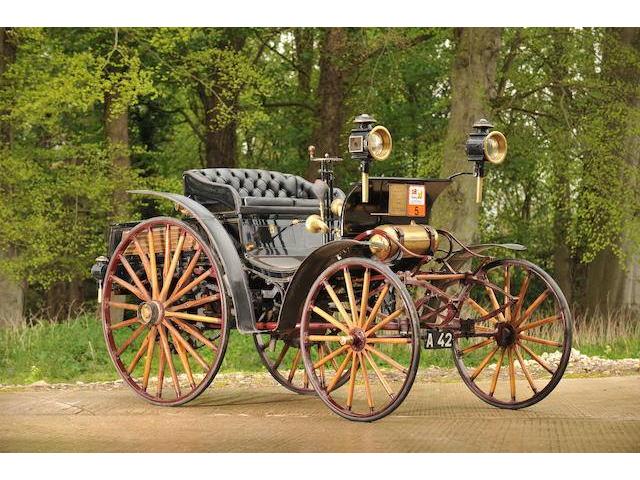1896 Benz 5hp Victoria
- Brand: Benz
1896 Benz 5hp Victoria
The first internal combustion-engined car which performed with any degree of success is generally attributed to German engineer Carl Benz and was a spindly three-wheeler with massive horizontally-mounted engine. Following Carl Benz’s first faltering run in that car in the Autumn of 1885 the German Press wrote, ‘this engine – velociped will make a strong appeal to a large circle, as it should prove itself quite practical and useful to doctors, travellers and lovers of sport.’ This first effort developed not less than 0.9hp giving a top speed approaching 8mph. By 1892 Benz cars had four wheels and the Velociped introduced in 1894 had a single-cylinder engine developing 1.5hp. As well as the Velociped, which was the best selling of all Benz products, they offered the Victoria, the Vis-à-vis, the Phaeton and, rarest of all, the Sommerwagen. The Velociped was the best selling car of its day and engine refinements resulted in 3 1/2hp being developed by 1895 or so. Engine sizes were progressively increased and by 1896 a 5hp car was marketed with bore and stroke of 150 x170mm and a cubic capacity of 3 litres. Benz had many imitators and their products were built under licence by other European manufacturers such as Hurtu, Star and Marshall. In France Émile Roger was their highly successful agent, taking a high proportion of Benz output. Production at Mannheim had risen from 69 cars during the period 1885 to 1893, 67 cars in 1894, 135 cars in 1895 and by 1896 output had climbed to 181 cars. The basic Benz design was to influence motor car production from 1885 to 1900 and only the arrival of the new ‘Système Panhard’ and also De Dion Bouton’s fast-revving vertical engines was to sound its deathknell.
This handsome Victoria is finished in black livery with varnished wooden wheels, (rebuilt in 2001), and maroon chassis detail. It is powered by the 5hp, single-cylinder engine, (dimensions 151mm x 171mm), with inlet over exhaust valve arrangement, fuelled by a surface carburettor, with trembler coil ignition and two-speed gearing, with drive by belt and chain. It is equipped with leather covered mudguards, candle side and rear lamps and audible warning of approach is provided both by bell and bulb horn – and presumably also vocally in those more stressful moments on the A23! The coachwork is furnished with buttoned black leather and suspension is provided by two full-elliptic front springs with a transverse full-elliptic spring on the steering, rear suspension being by full-elliptic leaf springs. On full song A 42 is a sight to behold on the open road, its suspension working overtime. In every respect this Mannheim product can truly be described as a horseless carriage, its styling and general design harking back perhaps fifty years in carriage design.
Descriptions & pictures by bonhams & mercedes-benz-publicarchive
| Specification | |
| Production Start | 1896 |
| Country of origin | Germany |




















